1995 GMC SIERRA parking brake
[x] Cancel search: parking brakePage 231 of 488
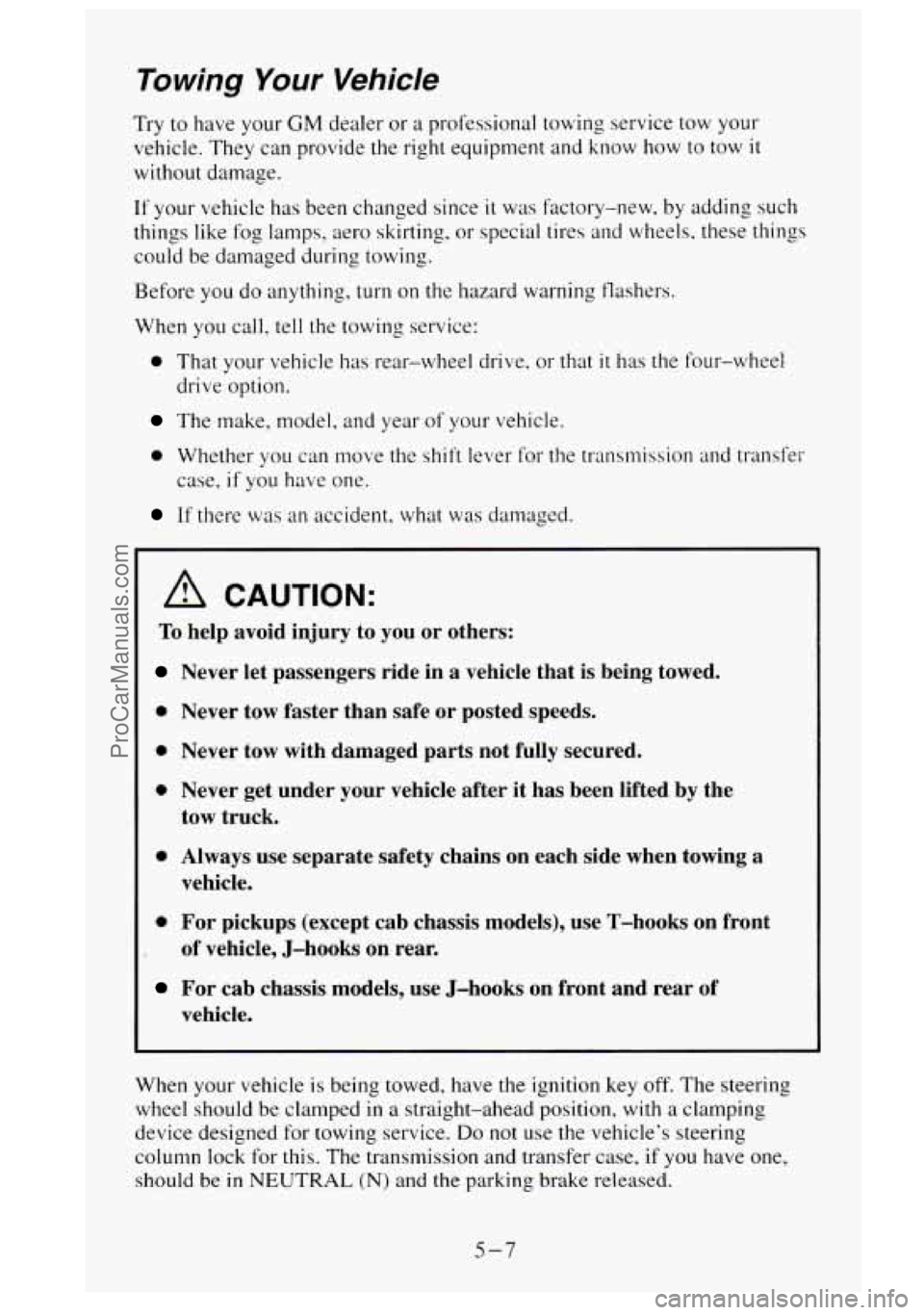
To wing Your Vehicle
Try to have your GM dealer or a professional towing service tow your
vehicle. They can provide the right equipment and know how to tow
it
without damage.
If your vehicle has been changed since
it was factory-new. by adding such
things like fog lamps, aero skirting,
or special tires and wheels, these things
could be damaged during towing.
Before you do anything,
turn on the hazard warning flashers.
When you call, tell the towing service:
0 That your vehicle has rear-wheel drive, or that it has the four-wheel
drive option.
The make, model, and year of your vehicle.
0 Whether you can move the shift lever for the transmission and transfer
case,
if you have one.
If there was an accident. what was damaged.
A CAUTION:
To help avoid injury to you or others:
Never let passengers ride in a vehicle that is being towed.
0 Never tow faster than safe or posted speeds.
0 Never tow with damaged parts not fuIly secured.
0 Never get under your vehicle after it has been lifted by the
tow truck.
0 Always use separate safety chains on each side when towing a
vehicle.
0 For pickups (except cab chassis models), use T-hooks on front
. of vehicle, J-hooks on rear.
For cab chassis models, use J-hooks on front and rear of
vehicle.
When your vehicle is being towed, have the ignition key off. The steering
wheel should be clamped
in a straight-ahead position, with a clamping
device designed for towing, service.
Do not use the vehicle’s steering
column lock for this. The transmission and transfer case, if
you have one,
should be
in NEUTRAL (N) and the parking brake released.
5-7
ProCarManuals.com
Page 273 of 488
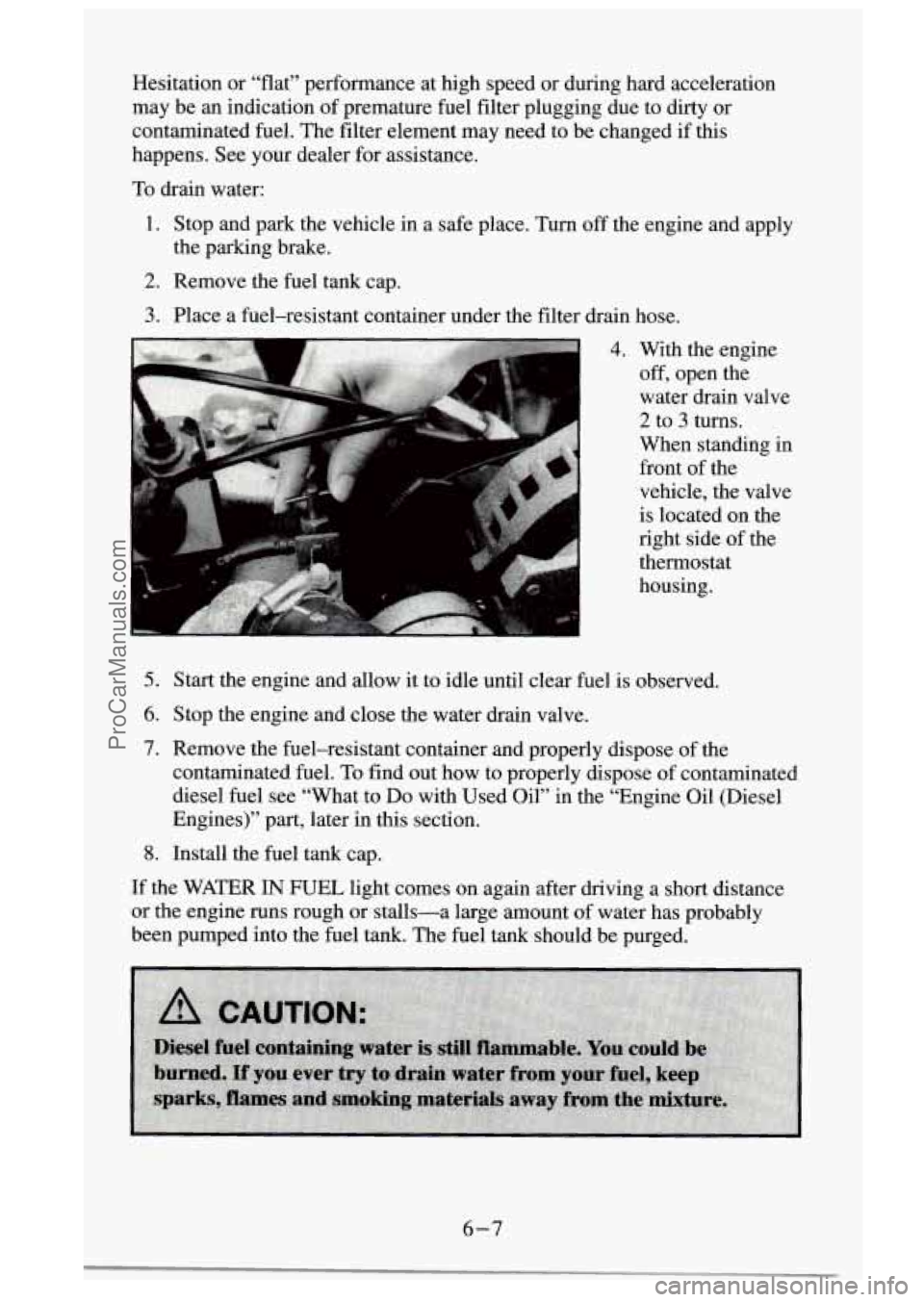
Hesitation or “flat” performance at high speed or during \
hard acceleration
may be an indication of premature fuel filter plugging due to dirty or
contaminated fuel. The fidter element may need to be changed
if this
happens. See your dealer for assistance.
To drain water:
1. Stop and park the vehicle in a safe place. Turn off the engine and apply
2. Remove the fuel tank cap.
the parking brake.
3. Place a
fuel-resistant container under the filter drain hose.
5.
6.
7.
8.
4. With the engine
off, open the
water drain valve
2 to 3 turns.
When standing in
front of the
vehicle, the valve
is located on the
right side of the
thermostat
housing.
Start the engine and allow it to idle until clear fuel is ob\
served.
Stop the engine and close the water drain valve.
Remove the fuel-resistant container and properly dispose of the
contaminated fuel.
To find out how to properly dispose of contaminated
diesel fuel see “What to Do with Used Oil” in the “E\
ngine Oil (Diesel
Engines)” part, later in this section.
Install the fuel tank cap.
If the WATER IN FUEL light comes on again after driving a short distance
or the engine runs rough or stalls-a large amount of water has probably
been pumped into the
fuel tank. The fuel tank should be purged.
6-7
ProCarManuals.com
Page 275 of 488
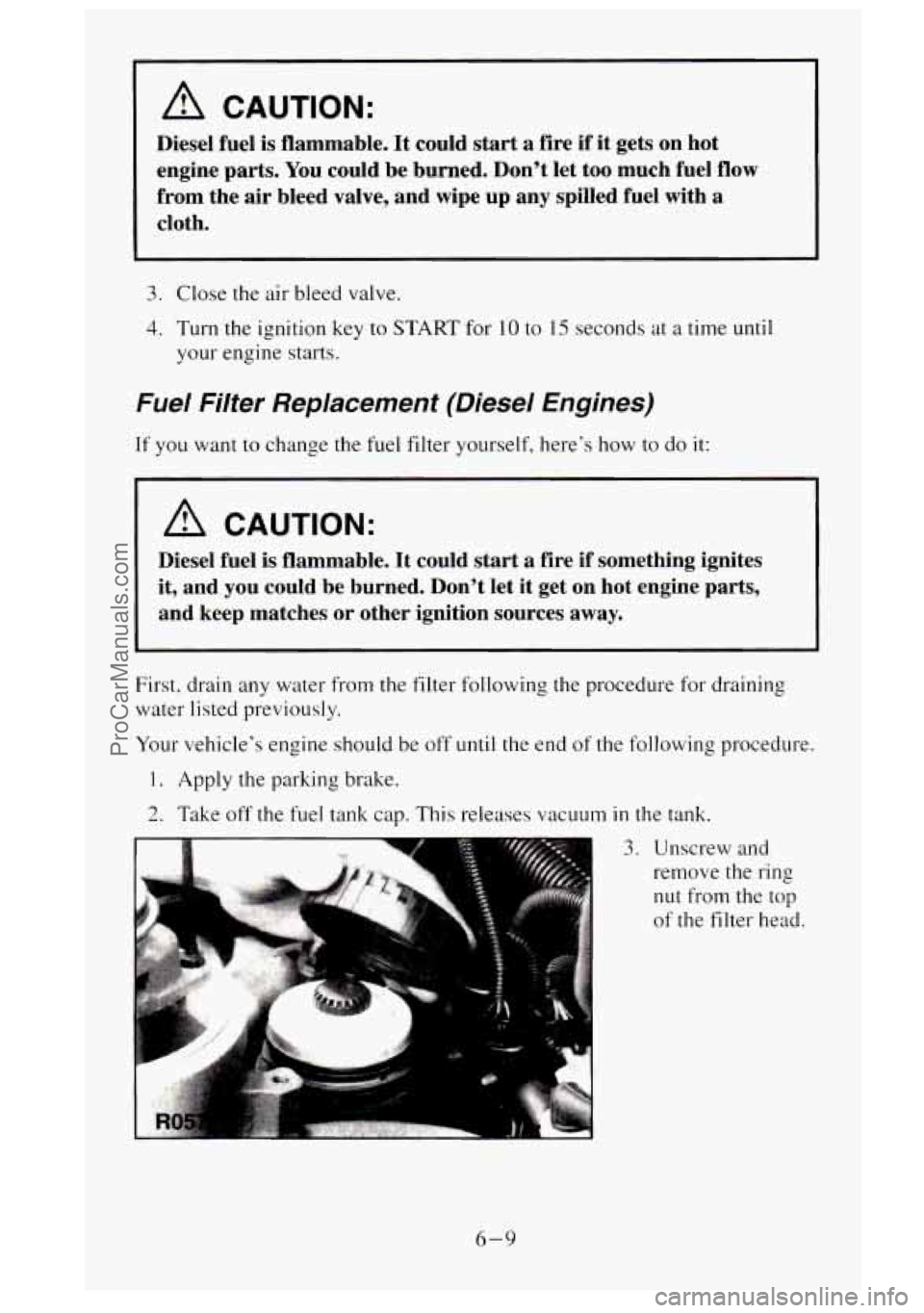
A CAUTION:
Diesel fuel is flammable. It could start a fire if it gets on hot
engine parts. You could be burned. Don't let too much fuel flow
from the air bleed
valve, and wipe up any spilled fuel with a
cloth.
3. Close the air bleed valve.
4. Turn the ignition key to START for 10 to 15 seconds at a time until
your engine starts.
Fuel Filter Replacement (Diesel Engines)
If you want to change the fuel filter yourself, here's how to do it:
A CAUTION:
Diesel fuel is flammable. It could start a fire if something ignites
it, and you could be burned. Don't let it get on hot engine parts,
and keep matches or other ignition sources away.
First. drain any water from the filter following the procedure for draining
water listed previously.
Your vehicle's engine should be off until the end
of the following procedure.
1. Apply the parking brake.
2. Take off the fuel tank cap. This releases vacuum in the tank.
3. Unscrew and
remove the ring
nut from the top
of the
filter head.
6-9
ProCarManuals.com
Page 294 of 488
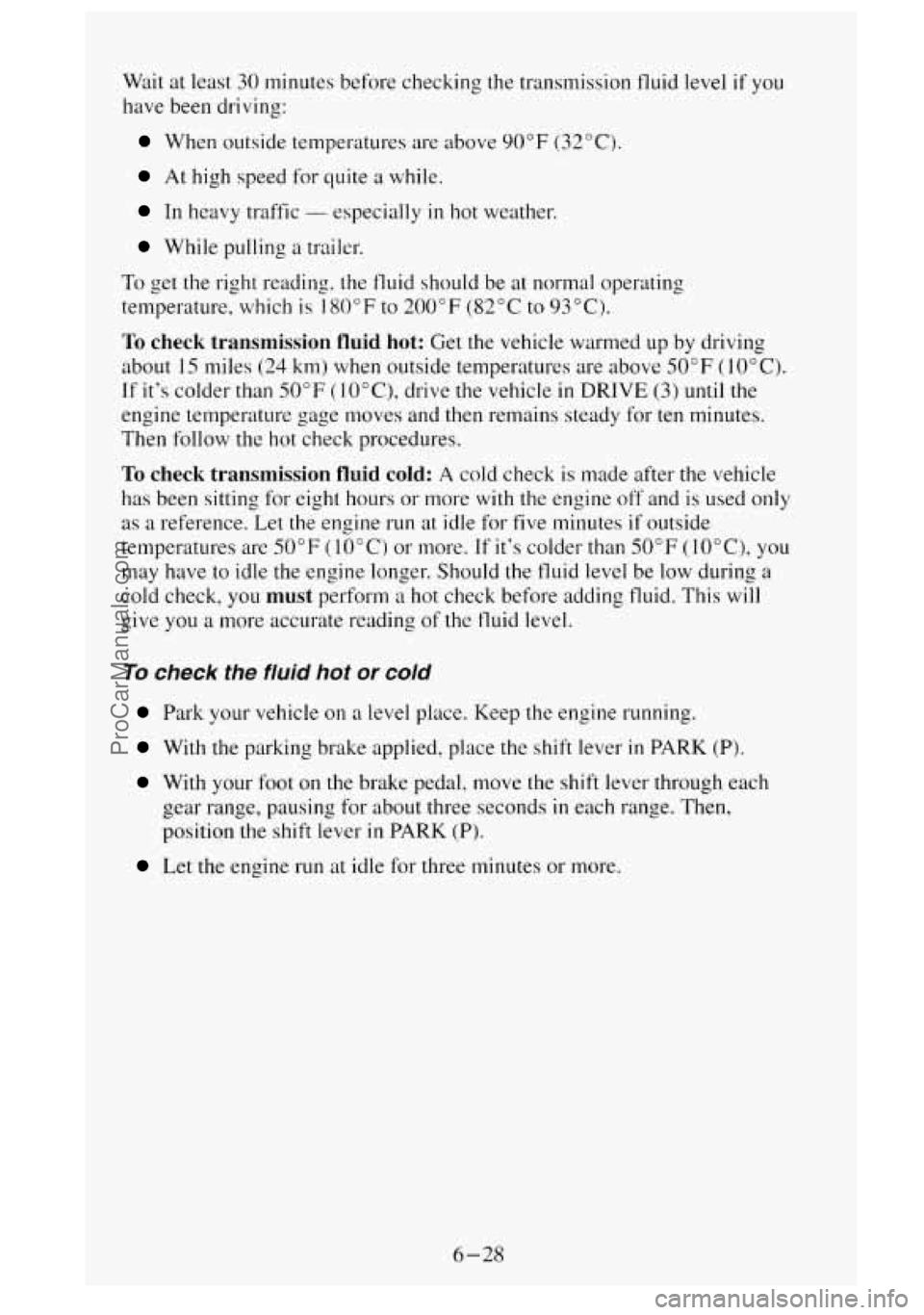
Wait at least 30 minutes before checking the transmission fluid level if you
have been driving:
When outside temperatures are above 90°F (32°C).
At high speed for quite a while.
In heavy traffic - especially in hot weather.
While pulling a trailer.
To get the right reading. the fluid should be at normal operating
temperature, which is 180°F to 200°F
(82°C to 93°C).
To check transmission fluid hot: Get the vehicle warmed up by driving
about
15 miles (24 km) when outside temperatures are above 50°F (10°C).
If it's colder than 50°F (lO"C), drive the vehicle in DRIVE (3) until the
engine temperature gage moves and then remains steady for ten minutes.
Then follow the hot check procedures.
To check transmission fluid cold: A cold check is made after the vehicle
has been sitting for eight hours or more
with the engine off and is used only
as a reference. Let the engine run at idle for five minutes if outside
temperatures are 50°F
(10°C) or more. If it's colder than 50°F (IOOC), you
may have to idle the engine longer. Should the fluid level be low during a
cold check, you
must perform a hot check before adding fluid. This will
give you a more accurate reading of the fluid level.
To check the fluid hot or cold
Park your vehicle on a level place. Keep the engine running.
With the parking brake applied, place the shift lever in PARK (P).
With your foot on the brake pedal, move the shift lever through each
gear range, pausing for about three seconds
in each range. Then,
position the shift lever
in PARK (P).
Let the engine run at idle for three minutes or more.
6-28
ProCarManuals.com
Page 369 of 488
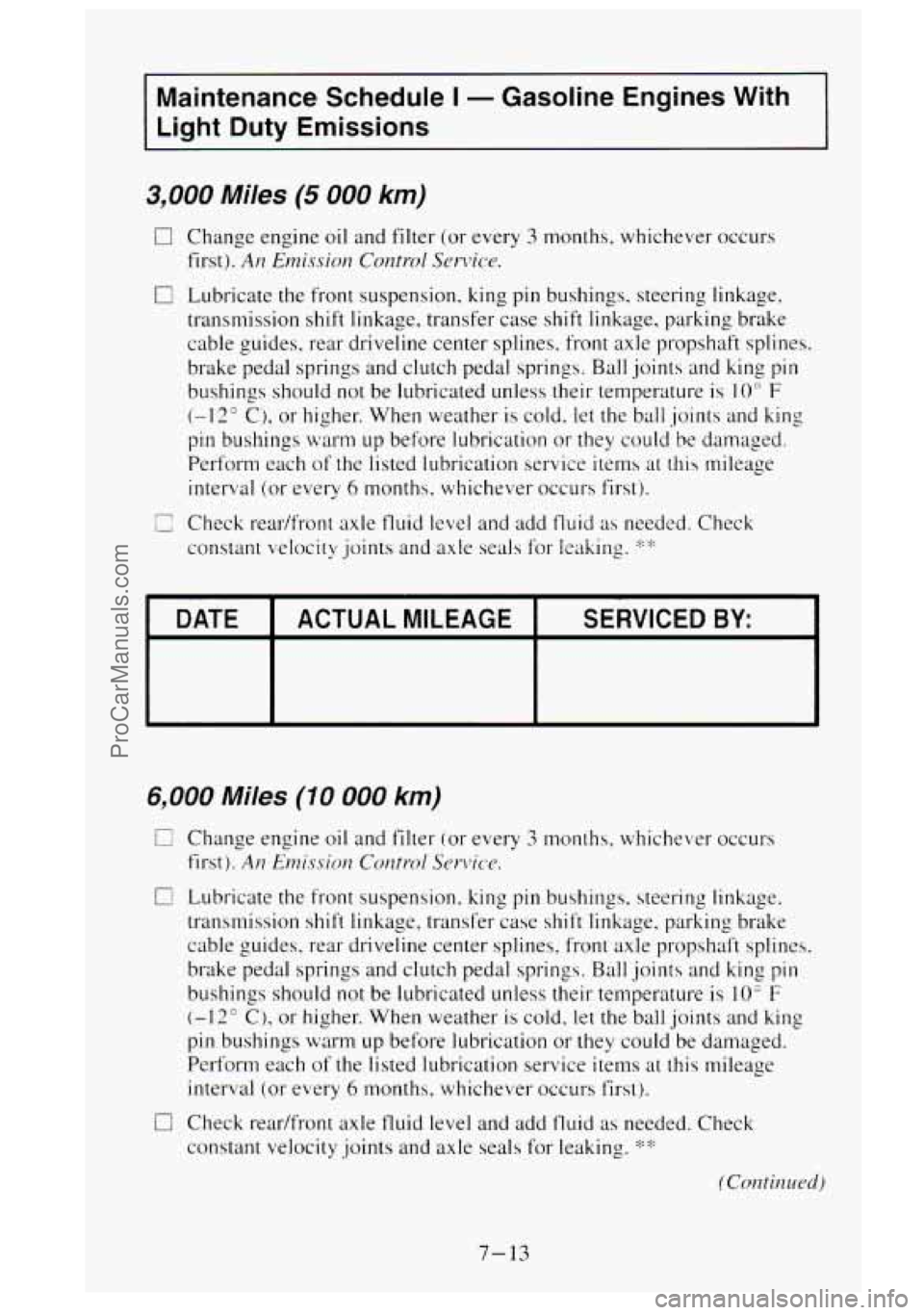
Maintenance Schedule I - Gasoline Engines With
Light Duty Emissions
3,000 Miles (5 000 km)
[7 Change engine oil and filter (or every 3 months, whichever occurs
first).
An Emission Control Sen7ic.e.
0 Lubricate the front suspension, king pin bushings, steering linkage,
transmission shift linkage. transfer case shift linkage, parking brake
cable guides, rear driveline center splines. front axle propshaft splines.
brake pedal springs and clutch pedal springs. Ball joints and king pin
bushings should not be lubricated unless their temperature is
10" F
(-1 2" C), or higher. When weather is cold, let the ball -joints and king
pin bushings warm up before lubrication or they could be damaged.
Perform each of the listed lubrication service items at this mileage
interval (or every
6 months, whichever occurs first).
C Check rear/front axle fluid level and add -fluid as needed. Check
constant velocity joints and
axle seals for leaking. *'*
DATE SERVICED BY: ACTUAL MILEAGE I
6,000 Miles (10 000 km)
iI Change engine oil and filter (or every 3 months, whichever occurs
first).
AI? Emission Confro1 Ser\lic.e.
Lubricate the front suspension, king pin bushings, steering linkage,
transmission shift linkage, transfer case shift linkage, parking brake
cable guides, rear driveline center splines, front axle propshaft splines.
brake pedal springs and clutch pedal springs. Ball joints and king pin
bushings should not be lubricated unless their temperature
is 10" E
(,-12" C), or higher. When weather is cold, let the ball joints and king
pin bushings warm up before lubrication
or they could be damaged.
Perform each of the listed lubrication service items at this mileage
interval (or every
6 months, whichever occurs first).
0 Check readfront axle fluid level and add fluid as needed. Check
constant velocity joints and axle seals for leaking.
*'$
(Contiwed)
7-13
ProCarManuals.com
Page 370 of 488
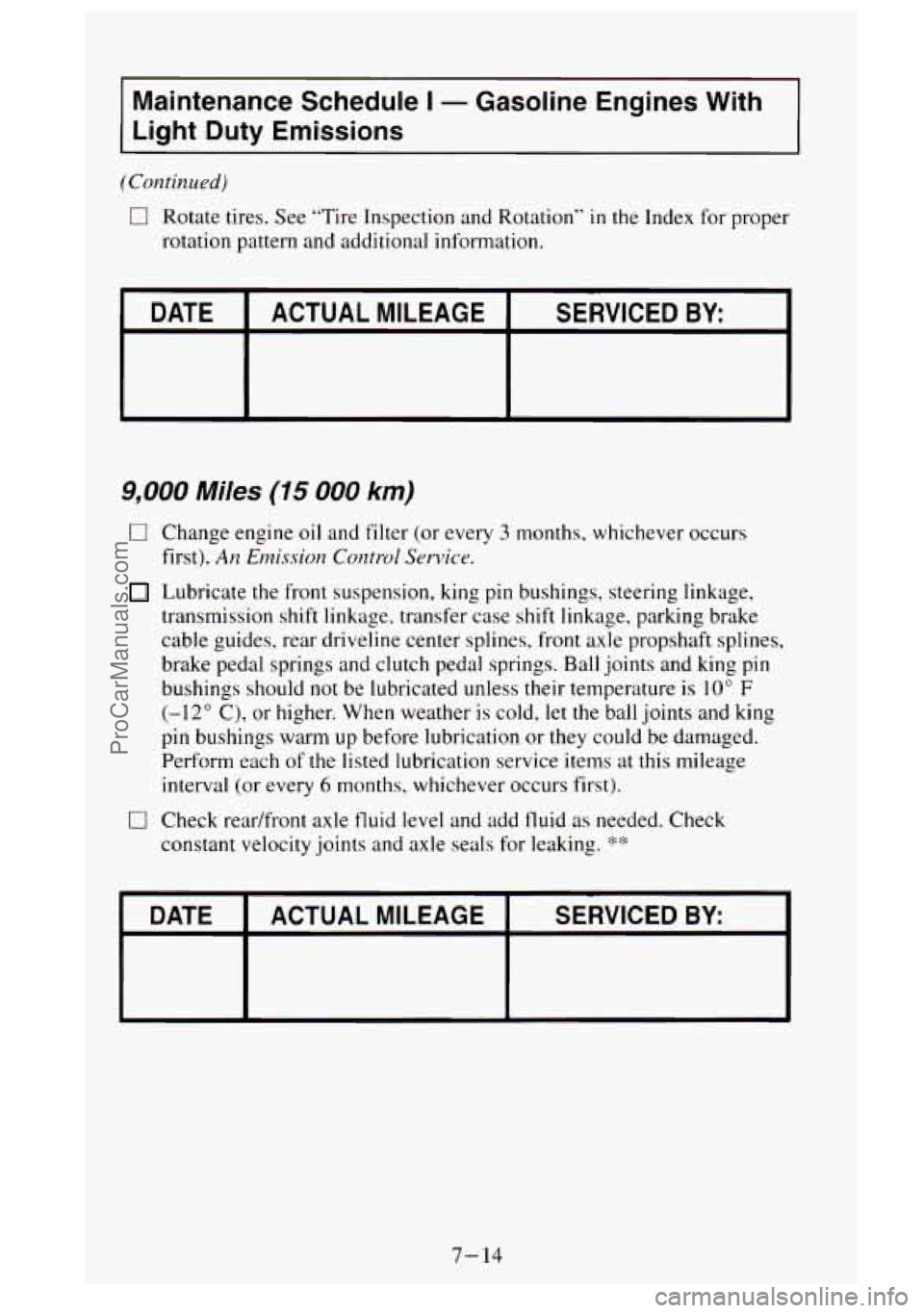
Maintenance Schedule I - Gasoline Engines With
Light
Duty Emissions ~~~~ ~~ ~ ~
(Continued)
0 Rotate tires. See "Tire Inspection and Rotation" in the Index for proper
rotation pattern and additional information.
I DATE I ACTUAL MILEAGE I SERVICED BY:
9,000 Miles (15 000 km)
0 Change engine oil and filter (or every 3 months, whichever occurs
first).
An Emission Control Service.
Lubricate the front suspension, king pin bushings, steering linkage,
transmission shift linkage, transfer case shift linkage, parking brake
cable guides, rear driveline center splines, front axle propshaft splines,
brake pedal springs and clutch pedal springs. Ball joints and king pin
bushings should
not be lubricated unless their temperature is IO" F
(-12" C), or higher. When weather is cold, let the ball joints and king
pin bushings warm up before lubrication or they could be damaged.
Perform each of the listed lubrication service items at this mileage
interval
(or every 6 months, whichever occurs first).
0 Check readfront axle fluid level and add fluid as needed. Check
constant velocity joints and axle seals for leaking.
*'g
DATE SERVICED BY: ACTUAL MILEAGE
7-14
ProCarManuals.com
Page 371 of 488
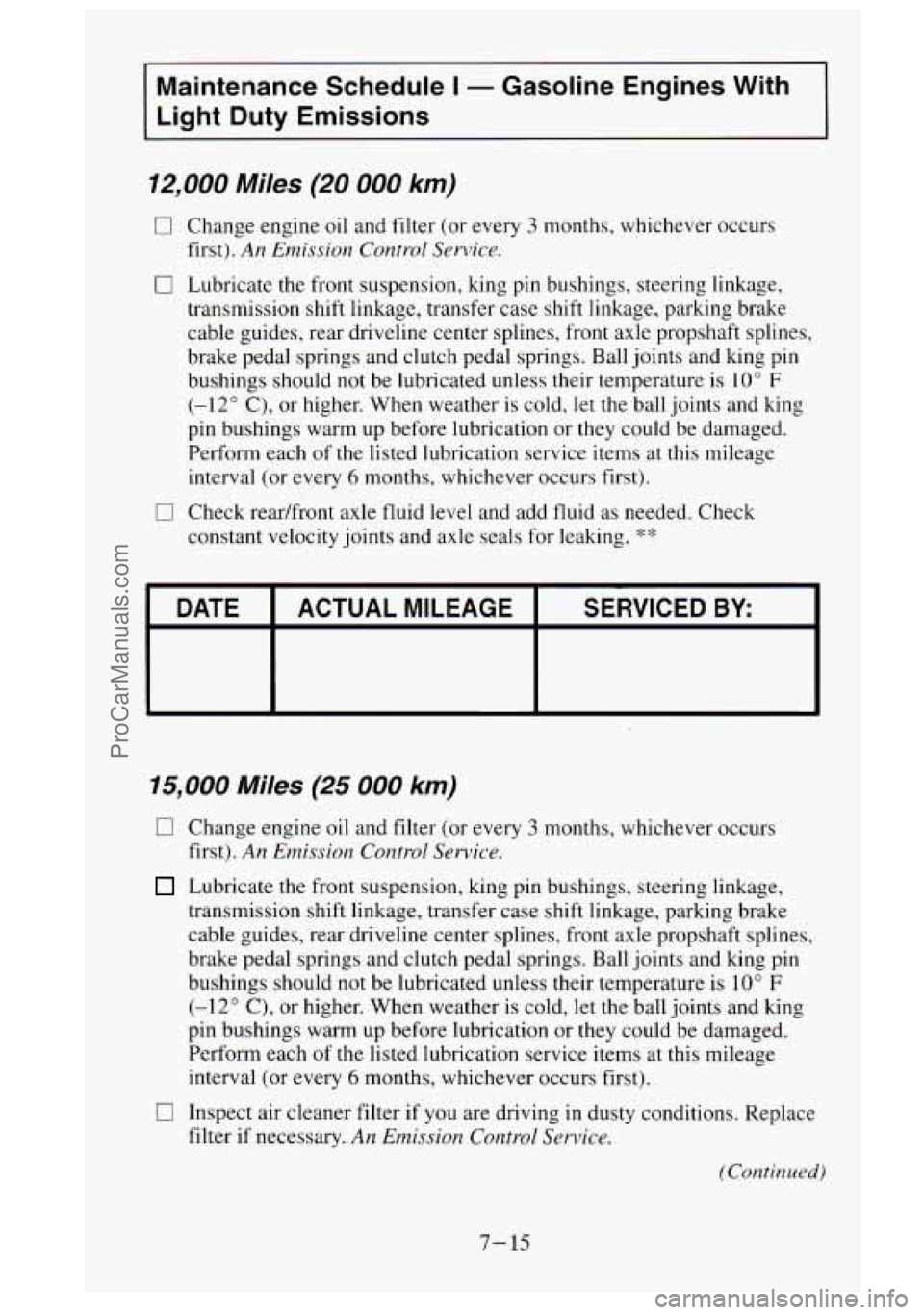
Maintenance Schedule I - Gasoline Engines With
Light Duty Emissions
12,000 Miles (20 000 km)
0 Change engine oil and filter (or every 3 months, whichever occurs
first).
An Emission Control Sewice.
0 Lubricate the front suspension, king pin bushings, steering linkage,
transmission shift linkage, transfer case shift linkage, parking brake
cable guides, rear driveline center splines, front axle propshaft splines,
brake pedal springs and clutch pedal springs. Ball joints and lung pin
bushings should not be lubricated unless their temperature is
10" F
(-12" C), or higher. When weather is cold, let the ball joints and king
pin bushings warm up before lubrication or they could be damaged.
Perform each of the listed lubrication service items at this mileage
interval (or every
6 months, whichever occurs first).
0 Check readfront axle fluid level and add fluid as needed. Check
constant velocity joints and axle seals for leaking.
**
I DATE I ACTUALMILEAGE I SERVICED BY: I
15,000 1 Ies (25 000 km)
0 Change engine oil and filter (or every 3 months, whichever occurs
first).
An Emission Control Service.
Lubricate the front suspension, king pin bushings, steering linkage,
transmission shift linkage, transfer case shift linkage, parking brake
cable guides, rear driveline center splines, front axle propshaft splines,
brake pedal springs and clutch pedal springs. Ball joints and king pin
bushings should not be lubricated unless their temperature is 10"
F
(-1 2 O C), or higher. When weather is cold, let the ball joints and king
pin bushings warm up before lubrication or they could be damaged.
Perform each
of the listed lubrication service items at this mileage
interval (or every
6 months, whichever occurs first).
0 Inspect air cleaner filter if you are driving in dusty conditions. Replace
filter if necessary.
An Emission Control Service.
(Continued)
7-15
ProCarManuals.com
Page 372 of 488
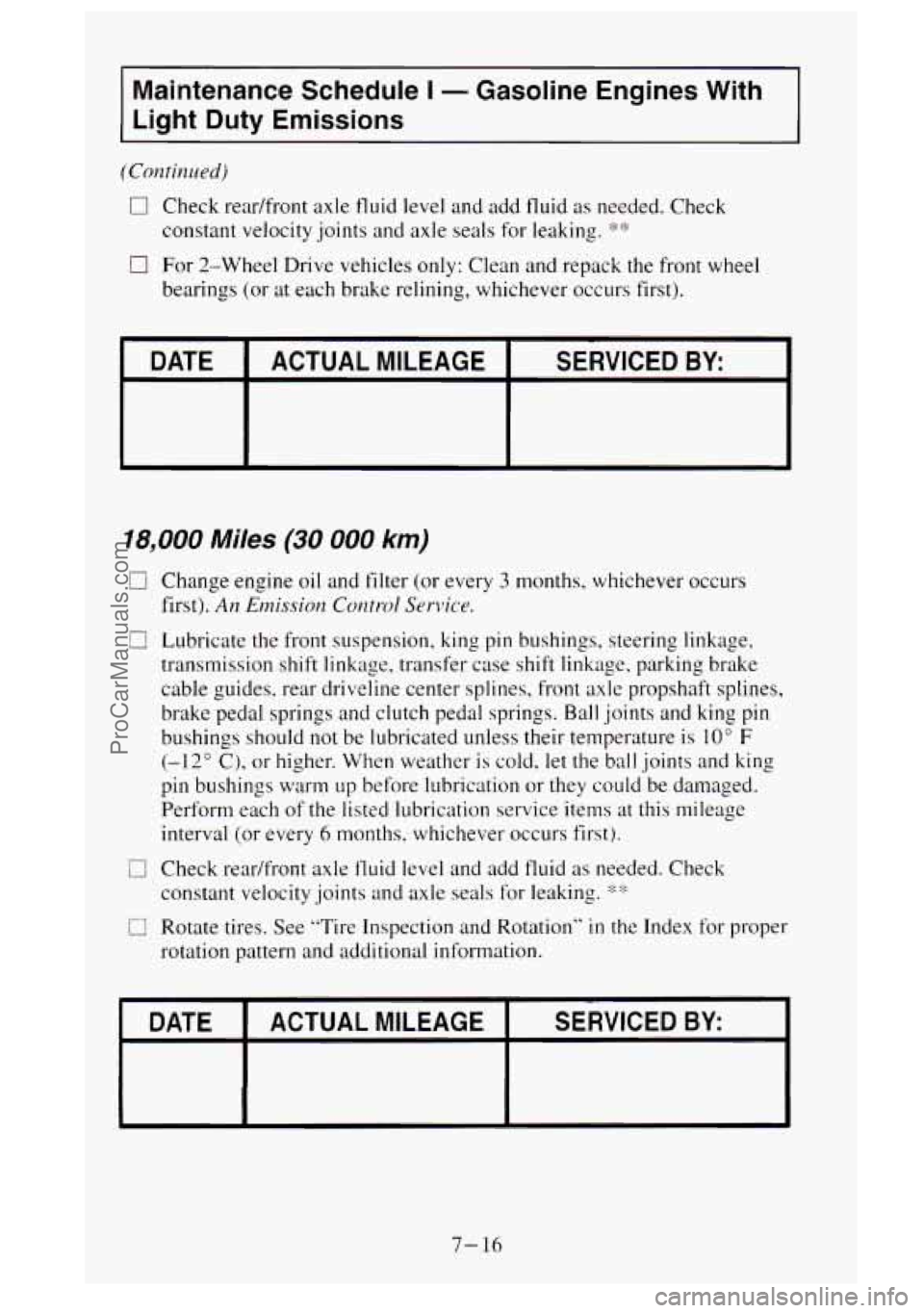
Maintenance Schedule I - Gasoline Engines With
Light Duty Emissions
(Continued)
0 Check rear/front axle fluid level and add fluid as needed. Check
constant velocity joints and axle seals for leaking.
'v'F
0 For 2-Wheel Drive vehicles only: Clean and repack the front wheel
bearings (or at each brake relining, whichever occurs first).
I H I
I DATE I ACTUALMILEAGE I SERVICED BY:
18,000 Miles (30 000 km)
ll Change engine oil and filter (or every 3 months, whichever occurs
first).
An Emission Corltrol Service.
IJ Lubricate the front suspension, king pin bushings, steering linkage,
transmission shift linkage, transfer case shift linkage, parking brake
cable guides. rear driveline center splines. front axle propshaft splines,
brake pedal springs and clutch pedal springs. Ball joints and king
pin
bushings should not be lubricated unless their temperature is 10" F
(-12" C), or higher. When weather is cold. let the ball joints and king
pin bushings warm
up before lubrication or they could be damaged.
Perform each of the listed lubrication service items at this mileage
interval (or every
6 months, whichever occurs first).
c3 Check readfront axle fluid level and add fluid as needed. Check
constant velocity joints and axle seals for leaking.
-&-'&- .> .!,
D Rotate tires. See "Tire Inspection and Rotation" in the Index for proper
rotation pattern and additional information.
DATE SERVICED BY: ACTUAL MILEAGE
7- 16
ProCarManuals.com